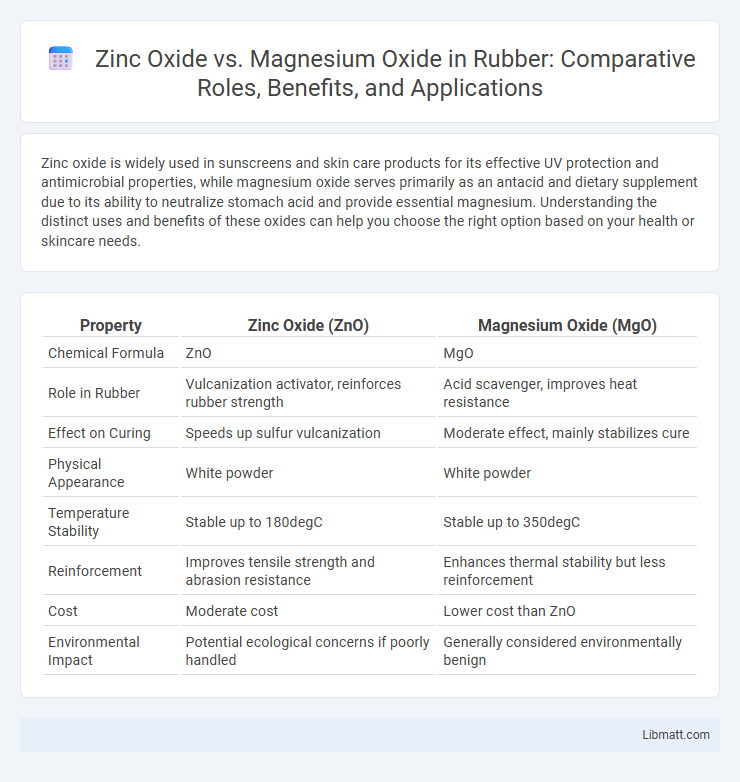Zinc oxide is widely used in sunscreens and skin care products for its effective UV protection and antimicrobial properties, while magnesium oxide serves primarily as an antacid and dietary supplement due to its ability to neutralize stomach acid and provide essential magnesium. Understanding the distinct uses and benefits of these oxides can help you choose the right option based on your health or skincare needs.
Table of Comparison
| Property | Zinc Oxide (ZnO) | Magnesium Oxide (MgO) |
|---|---|---|
| Chemical Formula | ZnO | MgO |
| Role in Rubber | Vulcanization activator, reinforces rubber strength | Acid scavenger, improves heat resistance |
| Effect on Curing | Speeds up sulfur vulcanization | Moderate effect, mainly stabilizes cure |
| Physical Appearance | White powder | White powder |
| Temperature Stability | Stable up to 180degC | Stable up to 350degC |
| Reinforcement | Improves tensile strength and abrasion resistance | Enhances thermal stability but less reinforcement |
| Cost | Moderate cost | Lower cost than ZnO |
| Environmental Impact | Potential ecological concerns if poorly handled | Generally considered environmentally benign |
Introduction to Zinc Oxide and Magnesium Oxide
Zinc oxide is a versatile inorganic compound commonly used in skincare products, sunscreens, and rubber manufacturing due to its excellent UV-blocking and antimicrobial properties. Magnesium oxide, a white hygroscopic solid, serves primarily as a refractory material, antacid, and magnesium supplement, valued for its high melting point and white powder form. Both compounds exhibit distinct chemical structures and applications, with zinc oxide being a semiconductor and magnesium oxide functioning as an electrical insulator.
Chemical Structure and Properties
Zinc oxide (ZnO) is a white, crystalline powder with a hexagonal crystal structure, known for its amphoteric nature, allowing it to react with both acids and bases. Magnesium oxide (MgO) features a cubic crystal structure and exhibits strong basic properties with high melting points, making it highly refractory and thermally stable. Your choice between these oxides may depend on their chemical reactivity and structural differences for specific applications such as catalysis, UV protection, or refractory materials.
Sources and Production Methods
Zinc oxide is primarily sourced from zinc ores such as sphalerite and produced through roasting zinc sulfide in air or direct oxidation of metallic zinc vapor. Magnesium oxide is typically obtained from magnesite or dolomite minerals, undergoing calcination at high temperatures to drive off carbon dioxide and form the oxide. Both compounds rely heavily on mining and thermal processing, but zinc oxide production often involves chemical vapor methods, whereas magnesium oxide is mainly derived from thermal decomposition of carbonate minerals.
Applications in Industry
Zinc oxide is widely used in the rubber industry as a vulcanization activator and in cosmetics for its UV protection and antibacterial properties. Magnesium oxide serves as a refractory material in furnace linings and as a basic component in agriculture to neutralize acidic soil. Your choice between these oxides depends on the specific industrial application, with zinc oxide favored for protective and antimicrobial uses, while magnesium oxide excels in heat resistance and soil treatment.
Uses in Skincare and Cosmetics
Zinc oxide and magnesium oxide are widely used minerals in skincare and cosmetics for their protective and soothing properties. Zinc oxide is commonly found in sunscreens, diaper rash creams, and calamine lotions due to its strong UV protection and anti-inflammatory benefits. Magnesium oxide, while less prevalent, is often used in exfoliants and masks to help absorb excess oil and improve skin texture, making it a valuable addition to your skincare routine.
Health Benefits and Medical Uses
Zinc Oxide provides strong antimicrobial properties and supports skin healing, often used in sunscreens and wound care to protect against infections and promote tissue repair. Magnesium Oxide acts primarily as an antacid and laxative, effectively relieving heartburn, indigestion, and constipation by neutralizing stomach acid and improving bowel movements. Your choice between these compounds should consider Zinc Oxide's topical benefits for skin health versus Magnesium Oxide's internal applications for digestive and metabolic support.
Safety Concerns and Toxicity
Zinc oxide is generally recognized as safe for topical use and low oral doses, but high ingestion can cause zinc toxicity, leading to nausea and vomiting. Magnesium oxide poses low toxicity risk with proper dosing, though excessive intake may cause digestive disturbances and electrolyte imbalance. Your careful consideration of dosage ensures safety when choosing between these mineral oxides in supplements or topical products.
Environmental Impact
Zinc oxide generally poses a lower environmental impact compared to magnesium oxide due to its higher stability and lower solubility, which reduces the risk of soil and water contamination. Magnesium oxide production often involves higher energy consumption and carbon emissions, contributing more significantly to environmental degradation. You can minimize ecological footprints by choosing zinc oxide in applications where environmental safety is a priority.
Cost and Availability Comparison
Zinc oxide is generally more expensive than magnesium oxide due to its widespread use in cosmetics, pharmaceuticals, and industrial applications, which drives higher demand and production costs. Magnesium oxide, being abundant and easily sourced from natural mineral deposits, offers a lower-cost alternative with extensive availability in bulk for construction, agriculture, and health supplements. Both compounds are commercially available worldwide, but magnesium oxide's lower price point and plentiful supply make it more accessible for large-scale industrial use.
Choosing the Right Oxide for Your Needs
Zinc oxide is highly effective for skin protection and soothing irritations, making it ideal for topical creams and sunscreen formulations. Magnesium oxide excels in dietary supplements to support bone health and digestive function due to its high bioavailability and antacid properties. Your choice between zinc oxide and magnesium oxide should depend on whether you need skin barrier support or mineral supplementation for overall wellness.
Zinc Oxide vs Magnesium Oxide Infographic

 libmatt.com
libmatt.com